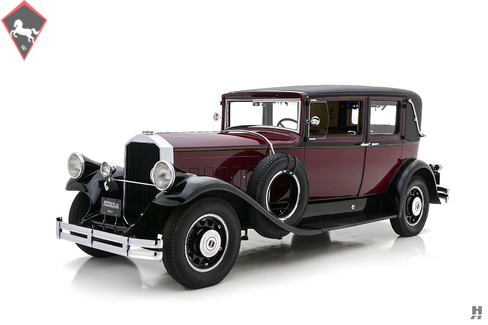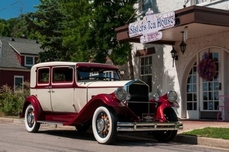Pierce-Arrow 840 A Model B Sedan 1930
General description :
Once the pride of Buffalo, New York, Pierce-Arrow created some of America's most prestigious and desirable automobiles of the pre-WWII era. After George N. Pierce bought out his partners in a manufacturing business, he shifted production from household goods to motor vehicles. The earliest steam-powered Pierce car failed to catch on; however, a switch to petrol power proved far more successful. The deDion-powered Pierce Motorette sold quite well, establishing the company on a solid footing for the future. In 1909, the company name changed to Pierce-Arrow, and the cars steadily grew in size and stature, earning the marque a deserved place in elite company alongside Packard and Peerless.
For the bulk of Pierce-Arrow production, the company relied on powerful T-head six-cylinder engines. During the brass and nickel eras, these were the Gold Standard of American engines, noted for their smooth running and impressive output. But as the 1920s wore on, the massive and inefficient T-head fell out of favor, replaced by more sophisticated designs. Pierce-Arrow management and buyers tended toward conservatism, so the tried-and-true T-head soldiered on into the 1920s. But slow sales and stringent quality control measures bordering on perfectionism meant there was little money to develop new models. Work on a modern L-head eight-cylinder engine was underway, but Pierce lacked the funding to bring it to production, further hampering new sales. Help arrived, at least temporarily, in 1928 when Studebaker's President Albert Erskine negotiated a merger with Pierce-Arrow. Under the agreement, Pierce could operate independently, with Erskine as president and a much-needed influx of cash allowed them to bring their L-head inline-eight to production the following year.
Things looked rosy for Pierce-Arrow, as the new engine revitalized the marque and sales doubled in 1929 to nearly 10,000 units. Unfortunately, the happy marriage was short-lived, as the Great Depression's economic impact was too deep to overcome. Studebaker fell into receivership in 1933, cutting Pierce-Arrow loose to struggle as an independent for a few more years. Yet Pierce-Arrow never compromised its quality, and their cars remained some of America's best until bankers locked the doors for good in 1938.
Offered to the public for the first time in seventy years, this 1930 Pierce-Arrow Model B sedan joined Al Frankel's stable back in 1950 and has remained a proud part of his collection until now. California registration cards document the car's long-term ownership, although little is known about its early history. Several years ago, Mr. Frankel initiated a complete, nut-and-bolt restoration via Mr. Jim Livings, though sadly, he would not see it to fruition. As offered, the coachwork, chassis, suspension, and drivetrain are restored and reassembled to a high standard, leaving only the interior upholstery to be completed to the new owner's preference.
The two-tone paintwork presents quite well and is finished to a good standard of quality in a handsome maroon and black scheme with gold coach stripes. Close inspection reveals a few minor imperfections in the finish, which do little to detract from the excellent overall presentation. The brightwork and bumpers are in superb order, and the car features a factory trunk rack, dual side-mount spares, wind wings, triple tail lamp, and auxiliary driving lamps. The black vinyl roof topping is in excellent order, accented with chrome decorative landau irons. Typical of Pierce-Arrows of the period, this car features robust artillery-style wheels in lieu of flashy, high-maintenance wires. The wheels are finished in black with chrome center caps and trim rings, and they provide a distinctly purposeful appearance, particularly with the black wall tires.
While the upholstery requires a full restoration, the dash, instrumentation, interior woodwork, and most primary controls are restored to a high standard. The interior is a blank canvas of sorts for the next owner to complete the striking livery. Under the hood, Pierce-Arrow's 125-horsepower L-Head eight is highly detailed with period-correct fittings, an oil filter canister, and proper paint finishes on the major components. The underside of the 139-inch wheelbase chassis is similarly well-dressed, and the black finish is in good order, with only some "shelf wear" due to the time elapsed between phases of the restoration.
Once completed, this handsome Pierce-Arrow will surely be a delightful and highly attractive tour car with room for the whole family. Its next keeper can delight in being only the second person in 70 years to own it, and it will undoubtedly provide many more years of motoring enjoyment.
Offers welcome and trades considered
https://hymanltd.com/vehicles/6690
1930 Pierce-Arrow 840 A Model B Sedan is listed sold on ClassicDigest in St. Louis by Mark Hyman for $29500.
Car Facts
Car type : Car Make : Pierce-Arrow Model : 840 A Model Version : Model B Sedan Engine size : 0.0 Model Year : 1930 Sub type : Sedan Location : Missouri
Sold
Seller Information
Sold
People who viewed this Pierce-Arrow 840 A also viewed similar Pierce-Arrow listed at ClassicDigest
Other cars listed for sale by this dealer
About Pierce-Arrow
Pierce-Arrow, once considered among America's most prestigious and luxurious automobile manufacturers, contributed significantly to automotive history with its innovation, craftsmanship, and distinctive design elements. Here's an overview of Pierce-Arrow, its history, notable models, and the renowned headlights:Pierce-Arrow: An American Icon
Early Beginnings and Foundation:
Origins: Established in 1865 as a manufacturer of household goods and later bicycles, Pierce-Arrow transitioned to automobiles in the early 20th century.
Automobile Production: Officially entered the automotive market in 1901, producing high-quality cars that targeted affluent buyers.
Milestones and Remarkable Models:
Pierce-Arrow Model 66 (1910-1918):
Powerhouse: Known for its powerful 12.7-liter six-cylinder engine, showcasing impressive performance for its time.
Luxury and Innovation: Set a standard for luxury, featuring advanced engineering and opulent amenities.
Pierce-Arrow Silver Arrow (1933):
Streamlined Design: Celebrated for its sleek, futuristic design with smooth, aerodynamic lines.
Limited Production: Only five examples were produced, making it one of the most sought-after and valuable cars in automotive history.
Iconic Headlights:
Signature Headlights: Pierce-Arrow's most distinctive feature was its trademark headlights, known as "Pierce-Arrow Headlights" or "Pierce-Arrow Headlamps."
Fender-Mounted Headlights: These headlights were mounted on the fenders rather than the traditional placement on the car's body or grille, contributing to the brand's recognizable design language.
Legacy and Influence:
Luxury and Elegance: Pierce-Arrow earned a reputation for producing some of the finest luxury cars in America, appealing to affluent buyers seeking quality and prestige.
Contributions to Automotive Design: The brand's innovative design elements, such as the fender-mounted headlights, left a lasting impact on automotive styling and aesthetics.
Decline and End:
Challenges and Transition: Economic downturns and changes in consumer preferences led to Pierce-Arrow's decline.
Final Years: The company faced financial struggles during the Great Depression and ceased automobile production in 1938.
Conclusion
Pierce-Arrow's legacy lies in its commitment to producing meticulously crafted, luxurious automobiles that exuded elegance and sophistication. Alongside its opulent vehicles, the brand's distinctive fender-mounted headlights became an enduring symbol of its unique design approach, contributing to its iconic status in automotive history despite its eventual disappearance.








